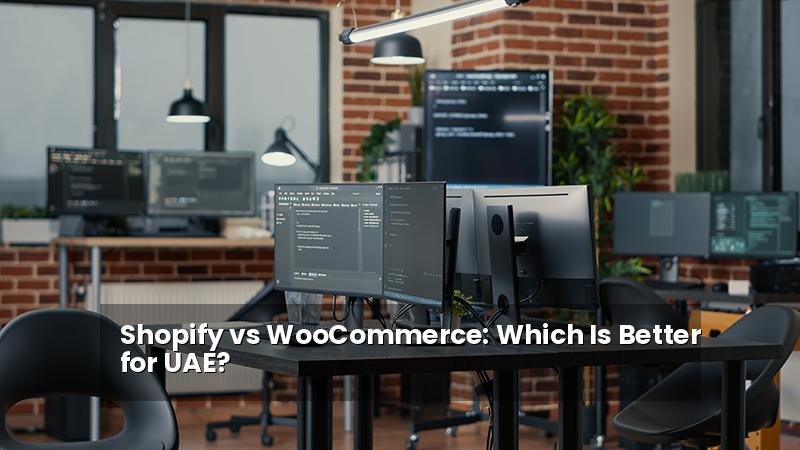Shopify vs WooCommerce: Which Is Better for UAE?
The UAE’s ecommerce market is booming, presenting incredible opportunities for businesses looking to sell online. But with so many platforms available, choosing the right one can feel overwhelming. Two giants dominate the scene: Shopify and WooCommerce. Both are powerful, but which one is the better fit for your business in the unique landscape of the UAE?
This article dives deep into a comparison of Shopify vs WooCommerce for the UAE market, breaking down their features, costs, flexibility, and how they stack up concerning essential factors like payment gateways and shipping solutions relevant to the region. By the end, you’ll have a clearer picture of which platform aligns best with your goals.
Understanding the Contenders
What is Shopify?
Shopify is a hosted ecommerce platform. This means it’s an all-in-one solution where Shopify handles the software, hosting, security, and updates. It’s a Software as a Service (SaaS) model, known for its ease of use and quick setup process.
Think of Shopify as renting a fully-equipped shop – you just need to add your products and branding. It’s popular globally and has a strong presence in the UAE, supporting businesses of all sizes from startups to large enterprises.
What is WooCommerce?
WooCommerce is a free, open-source plugin specifically designed for WordPress, the world’s most popular content management system. It transforms a WordPress website into a fully functional online store.
WooCommerce is more like building your own shop on land you own (your hosting). While the plugin itself is free, you are responsible for hosting, security, maintenance, and potentially paying for themes and extensions (plugins) to add specific functionalities. It offers immense flexibility and customization.
Shopify vs WooCommerce: A Head-to-Head Comparison for UAE Businesses
Choosing the right platform is critical for success in the competitive UAE market. Let’s compare them based on key factors relevant to businesses operating here:
Ease of Use and Setup
Shopify: Generally considered much easier for beginners. The interface is intuitive, and launching a basic store can be done relatively quickly without any coding knowledge. You sign up, pick a plan, choose a theme, add products, and set up payments/shipping. All the technical backend is handled for you, which is a significant advantage if you’re new to ecommerce or not technically inclined.
WooCommerce: Requires more technical know-how. You first need to set up WordPress hosting, install WordPress, then install the WooCommerce plugin. While setting up basic products is straightforward within the WordPress dashboard, configuring shipping zones, taxes, and integrating specific payment gateways often requires navigating more settings or installing additional plugins. It has a steeper learning curve.
Cost
Shopify: Operates on a monthly subscription model. Plans range from basic to advanced, with higher tiers offering lower transaction fees and more features. Be aware of transaction fees (ranging from 0.5% to 2.0%) if you don’t use Shopify Payments (which is widely available and recommended). Additional costs include paid themes and apps.
WooCommerce: The plugin is free, but you have recurring costs for hosting, domain name, and potentially paid themes, plugins (for SEO, marketing, specific features, etc.), and developer time for customization. Transaction fees are typically charged by your chosen payment gateway, not by WooCommerce itself. Costs can vary greatly depending on your hosting provider and the number of paid extensions you need.
For UAE: Consider hosting costs carefully for WooCommerce – reliable hosting in the region is essential for performance. For Shopify, factor in the monthly fee and potential transaction fees when calculating your overall costs.
Customization and Flexibility
Shopify: Offers customization through themes and a vast App Store. Most common functionalities can be added via apps. However, deep customization often requires working with Shopify’s proprietary templating language (Liquid) and can be more restricted compared to WooCommerce.
WooCommerce: Extremely flexible due to its open-source nature and being built on WordPress. You have full control over the code, allowing for virtually unlimited customization. The WordPress ecosystem offers a massive number of themes and plugins, covering almost any imaginable feature. This is great if you have unique requirements but can also lead to compatibility issues if not managed properly.
Scalability
Shopify: Designed to scale easily. Shopify handles the infrastructure upgrades as your store grows, ensuring speed and reliability even during peak traffic periods like sales events or holidays. You simply upgrade your plan as needed.
WooCommerce: Scales based on your hosting environment. As your store grows and traffic increases, you’ll need to upgrade your hosting plan. While WooCommerce itself can handle large catalogs and orders, the performance is directly tied to the quality and capacity of your hosting provider. You are responsible for managing this infrastructure growth.
SEO Capabilities
Shopify: Provides built-in SEO features like customizable meta titles/descriptions, alt tags, and sitemaps. It’s generally considered SEO-friendly out-of-the-box. Its App Store also offers various SEO plugins to enhance capabilities.
WooCommerce: Being built on WordPress, which is renowned for its SEO capabilities, WooCommerce benefits significantly. With powerful SEO plugins like Yoast SEO or Rank Math, you have very granular control over your on-page SEO. While WooCommerce itself is good for SEO, the core strength comes from the WordPress platform and its extensive range of SEO tools.
For UAE: Both platforms allow you to optimize for local keywords and target specific regions within the UAE. The best results depend more on your SEO strategy than the platform itself.
Payment Gateways (Crucial for UAE)
Shopify: Integrates seamlessly with Shopify Payments, which supports major credit cards and popular payment methods. It also has integrations with many third-party payment gateways widely used in the UAE, such as Checkout.com, PayTabs, Stripe (available in UAE), Tabby (BNPL), Tamara (BNPL), and others. Setting these up is usually straightforward via the Shopify dashboard or an app.
WooCommerce: Supports a vast array of payment gateways via extensions/plugins. You can find plugins for international gateways like Stripe, PayPal, and Square, as well as many local and regional gateways popular in the UAE (like PayTabs, Checkout.com, HyperPay, BNPL providers, etc.). You’ll need to install and configure the specific plugin for each gateway you wish to offer.
For UAE: Both platforms offer good support for popular payment methods. The key is to ensure the specific gateways your target audience uses are easily integratable with your chosen platform. Providing options like local card processing and popular BNPL services is essential in the UAE.
Shipping and Logistics (Crucial for UAE)
Shopify: Offers built-in shipping tools to set up rates based on location, weight, or price. It integrates with many global and regional shipping carriers via apps. Many popular UAE carriers (like Aramex, Emirates Post, Fetchr, DHL UAE, etc.) have Shopify apps or can be integrated using third-party shipping software that connects to Shopify.
WooCommerce: Provides flexible shipping options, allowing setup of complex rules, shipping zones (essential for different rates within Emirates or internationally), and carrier-calculated rates via extensions. Like payment gateways, integrating with specific UAE carriers often requires finding and installing the relevant plugin or using a shipping management plugin that supports them.
For UAE: Efficient shipping is vital. Both platforms allow integration with local carriers, but the ease of setup might differ. Researching the availability and quality of plugins/apps for your preferred UAE shipping partners on each platform is important.
Support
Shopify: Offers 24/7 customer support via email, live chat, and phone (depending on the plan). They have a comprehensive help center and community forums. This direct support is a major benefit, especially if you encounter technical issues you can’t resolve yourself.
WooCommerce: As an open-source platform, there is no direct “WooCommerce support” line. Support primarily comes from the vast community forums, documentation, and the developers of specific themes or plugins you use. If you need dedicated support, you typically need to hire a WordPress/WooCommerce developer.
Ownership and Control
Shopify: You don’t technically “own” your store; you rent it. Your store exists on Shopify’s servers. While you own your data, your store is dependent on the Shopify platform. If you stop paying, your store goes offline.
WooCommerce: You own your store entirely. It lives on your hosting account. You have full control over your data and codebase. This gives you maximum flexibility but also means you are responsible for backups, security updates, and overall maintenance.
Pros and Cons Summary
Shopify Pros for UAE
- Easy to set up and use, perfect for beginners.
- All-in-one hosted solution (hosting, security, maintenance included).
- Reliable and fast infrastructure.
- Excellent built-in support.
- Strong App Store ecosystem with many relevant UAE integrations (payment, shipping).
- Scales easily without infrastructure worries.
Shopify Cons for UAE
- Monthly subscription cost adds up.
- Transaction fees if not using Shopify Payments.
- Less customization flexibility compared to WooCommerce.
- Reliance on apps for extra functionality can increase costs.
WooCommerce Pros for UAE
- Free core plugin.
- Immense customization and flexibility (open source).
- Full ownership and control over your data and store.
- Leverages the power and SEO benefits of WordPress.
- Large community and vast ecosystem of themes and plugins (many relevant for UAE).
- Potentially lower transaction costs (via payment gateways).
WooCommerce Cons for UAE
- Steeper learning curve, requires more technical skill.
- Responsible for hosting, security, backups, and maintenance.
- Support relies on community or hiring developers.
- Costs can become unpredictable with premium themes/plugins and hosting upgrades.
- Potential plugin conflicts can arise.
Which is Better for UAE?
There is no single “better” platform; the best choice depends entirely on your specific needs, technical comfort level, budget, and business model in the UAE.
Choose Shopify if:
- You are new to ecommerce and want a hassle-free, quick setup.
- You prefer a fixed monthly cost and want included support.
- You want to focus on selling without worrying about technical maintenance.
- Your business requires standard ecommerce features that can be covered by themes and common apps.
- You prioritize ease of use and getting your store live fast in the competitive UAE market.
Choose WooCommerce if:
- You have an existing WordPress site or are comfortable with the platform.
- You need deep customization or have complex, unique requirements.
- You are technically proficient or have access to a developer.
- You want full control over your platform and data.
- You are looking to potentially minimize monthly fees and manage costs through open-source solutions.
- You plan to heavily integrate your store with content marketing on WordPress.
Both platforms are fully capable of powering a successful online store in the UAE, supporting local currencies, payment gateways, and shipping providers. Your decision should be based on which platform’s philosophy and structure better align with your resources and long-term vision.
Conclusion
The ecommerce platform UAE businesses choose is a critical decision. Both Shopify and WooCommerce offer robust features to sell online in the Emirates. Shopify excels in simplicity, speed, and support, making it ideal for startups and those prioritizing ease of use. WooCommerce offers unparalleled flexibility and control, perfect for businesses with unique needs or existing WordPress expertise.
Evaluate your technical skills, budget, desired level of customization, and how quickly you need to launch. Consider which platform’s ecosystem of apps (for Shopify) or plugins (for WooCommerce) best supports the local payment and shipping solutions crucial for operating smoothly in the UAE.
Ultimately, the most effective online store UAE businesses build will be the one on the platform they can manage most efficiently to reach and serve their customers.
If you need expert guidance on choosing the right platform or developing your ecommerce website in UAE, feel free to explore the services offered on my homepage.





